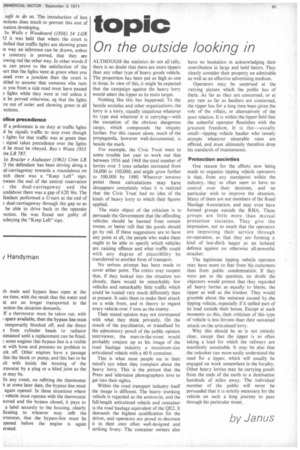topic
Page 67

If you've noticed an error in this article please click here to report it so we can fix it.
On the outside looking in
ALTHOUGH the statistics do not all tally. there is no doubt that there are more tippers than any 'other type of heavy goods vehicle. The proportion has been put as high as one in three. In view of this, it might be expected that the campaign against the heavy lorry would select the tipper as its main target.
Nothing like this has happened. To the hostile societies and other organizations, the lorry is a lorry, equally iniquitous whatever its type and whatever it is carrying—with the exception of the obvious dangerous cargo, which compounds the iniquity further. For this reason alone, much of the propaganda, however well-documented, is beside the mark.
For example, the Civic Trust went to some trouble last year to work out that between 1956 and 1968 the total number of lorries over 5 tons unladen increased from 34,000 to 150,000, and might grow further to 500.000 by 1980. Whatever tenuous point these calculations may have disappears completely when it is realized that the Civic Trust had no idea of the kinds of heavy lorry to which their figures applied.
The main object of the criticism is to persuade the Government that the offending vehicles should be banned from certain routes, or better still that the goods should go by rail. If these suggestions are to have any point at all, the people who make them ought to be able to specify which vehicles are catising offence and what traffic could with any degree of plausibility be transferred to another form of transport.
No serious attempt has been made to cover either point. The critics may suspect that, if they looked into the situation too closely, there would be remarkably few vehicles and remarkably little traffic which could be routed very much differently than at present. It suits them to make their attack on a wide front, and in theory to regard every vehicle over 5 tons as the enemy.
Their stated opinion may not correspond with what they think privately. On the couch of the psychiatrist, or transfixed by the admonitory pencil of the public opinion interviewer, the man-in-the-street would probably conjure up as his image of the road haulage industry a maximum-size articulated vehicle with a 40 ft container.
This is what most people see in their mind's eye when they complain about the heavy lorry. This is the picture that the Press and television photographers love to get into their sights.
Within the road transport industry itself the image is different. The heavy trunking vehicle is regarded as the aristocrat, and the full-length articulated vehicle and container is the road haulage equivalent of the QE2. It demands the highest qualification for the driver, and operators are proud to decorate it in their own often well-designed and striking livery. The container owners also have no hesitation in acknowledging their contribution in large and bold letters. They clearly consider their property an admirable as well as an effective advertising medium.
Operators may be surprised at the varying picture which the public has of them. As far as they are concerned, or at any rate as far as hauliers are concerned, the tipper has for a long time been given the role of the villain, or alternatively of the poor relation. It is within the tipper field that the unlawful operator flourishes with the greatest freedom. It is the—usually small—tipping vehicle haulier who tamely accepts whatever miserable rates are offered, and must ultimately therefore drop his standards of maintenance.
Protection societies One reason for the efforts now being made to organize tipping vehicle operators is that. from any standpoint within the industry, they so often seem to have no control over their destinies, and no particular wish to improve the situation. Many of them are not members of the Road Haulage Association, and may even have formed groups outside the RHA. These groups are little more than mutual protection societies. They give the impression, not so much that the operators are improving their service through co-operation, as that they are forming a kind of last-ditch laager as an isolated defence against an otherwise all-powerful attacker.
The legitimate tipping vehicle operator may have more to fear from his customers than from public condemnation. If they were put to the question, no doubt the objectors would protest that they regarded all heavy lorries as equally' to blame, the tipper as well as the trunker. They would grumble about the nuisance caused by -the tipping vehicle, especially if it spilled part of its load outside their house. Except at such moments as this, their criticism of this type of vehicle is less fervent than their sustained attack on the articulated lorry.
Why this should be so is not entirely clear, except that the tipper is so often taking a load for which the railways are manifestly unsuitable. It may be also that the onlooker can more easily understand the need for a tipper, which will usually be engaged on work somewhere in the locality. Other heavy lorries may be carrying goods from the ends of the earth to a destination hundreds of miles away. The individual member of the public will never be persuaded that it is strictly necessary for the vehicle on such a long journey to pass through his particular street.
by Janus










































































































































